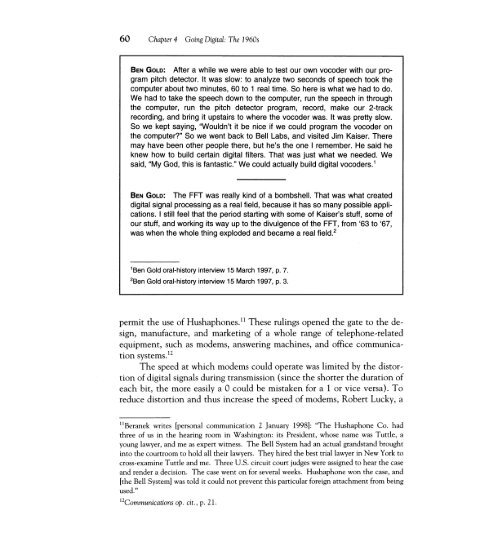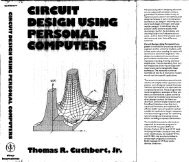Going Digital: The 1960s - IEEE Global History Network
Going Digital: The 1960s - IEEE Global History Network
Going Digital: The 1960s - IEEE Global History Network
You also want an ePaper? Increase the reach of your titles
YUMPU automatically turns print PDFs into web optimized ePapers that Google loves.
60 Chapter 4 <strong>Going</strong> <strong>Digital</strong>: <strong>The</strong> <strong>1960s</strong><br />
BEN GOLD: After a while we were able to test our own vocoder with our program<br />
pitch detector. It was slow: to analyze two seconds of speech took the<br />
computer about two minutes, 60 to 1 real time. So here is what we had to do.<br />
We had to take the speech down to the computer, run the speech in through<br />
the computer, run the pitch detector program, record, make our 2-track<br />
recording, and bring it upstairs to where the vocoder was. It was pretty slow.<br />
So we kept saying, "Wouldn't it be nice if we could program the vocoder on<br />
the computer?" So we went back to Bell Labs, and visited Jim Kaiser. <strong>The</strong>re<br />
may have been other people there, but he's the one I remember. He said he<br />
knew how to build certain digital filters. That was just what we needed. We<br />
said, "My God, this is fantastic." We could actually build digital vocoders. 1<br />
BEN GOLD: <strong>The</strong> FFT was really kind of a bombshell. That was what created<br />
digital signal processing as a real field, because it has so many possible applications.<br />
I still feel that the period starting with some of Kaiser's stuff, some of<br />
our stuff, and working its way up to the divulgence of the FFT, from '63 to '67,<br />
was when the whole thing exploded and became a real field. 2<br />
1Ben Gold oral-history interview 15 March 1997, p. 7.<br />
2Ben Gold oral-history interview 15 March 1997, p. 3.<br />
permit the use of Hushaphones. 11 <strong>The</strong>se rulings opened the gate to the de..<br />
sign, manufacture, and marketing of a whole range of telephone..related<br />
equipment, such as modems, answering machines, and office communica..<br />
tion systems. 12<br />
<strong>The</strong> speed at which modems could operate was limited by the distor..<br />
tion of digital signals during transmission (since the shorter the duration of<br />
each bit, the more easily a 0 could be mistaken for a 1 or vice versa). To<br />
reduce distortion and thus increase the speed of modems, Robert Lucky, a<br />
llBeranek writes [personal communication 2 January 1998]: "<strong>The</strong> Hushaphone Co. had<br />
three of us in the hearing room in Washington: its President, whose name was Tuttle, a<br />
young lawyer, and me as expert witness. <strong>The</strong> Bell System had an actual grandstand brought<br />
into the courtroom to hold all their lawyers. <strong>The</strong>y hired the best trial lawyer in New York to<br />
cross...examine Tuttle and me. Three U.S. circuit court judges were assigned to hear the case<br />
and render a decision. <strong>The</strong> case went on for several weeks. Hushaphone won the case, and<br />
[the Bell System] was told it could not prevent this particular foreign attachment from being<br />
used."<br />
12Communications op. cit., p. 21.
















